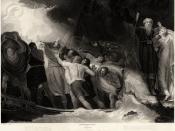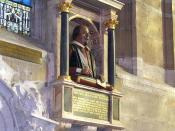The Tempest, written in 1611, was one of William Shakespeare's last plays. It has a combination of superb characters, interesting settings, and a good plot line--all held together by the running theme of magic, and its ever-present importance. A closer examination of the magic in The Tempest, and the public's view of magic at the time, will give insight as to Shakespeare's choice of magic as a theme, and why it has made the play so successful and timeless.
Magic presented itself to Shakespeare as a controversial topic, as it had been the persecution of those believed to perform 'black magic,' (witches) that had been at the forefront of societal concerns since 1050. However, after 500 years of witch-hunts, a turning point occurred in 1584, at the publication of Reginald Scot's The Discouerie of Witchcrafte (The Discovery of Witchcraft). This book was the first major book to denounce witch-hunts and their ringleaders, and unquestionable the first book in English to actually hypothesize about the methods of these so-called witches.
It contained one chapter of approximately twenty pages describing what we might view as unsophisticated, old-time magic tricks.
One would assume that it was this text, and texts succeeding this (The Art of Juggling, written by Samuel Ridd in 1610 also presented a few how-to's of magic) were probably not only what suggested the idea of using magic as a them to Shakespeare, but in addition, provided methods as to how the magic in the play might be accomplished.
Despite the fact that in retrospective analysis it is fairly clear that witches were nothing more that magicians with a slightly different presentation, audiences were not always aware of -and those that were, were rarely convinced by--the two aforementioned texts. Witches were still persecuted and witch-hunts did not actually stop until...


